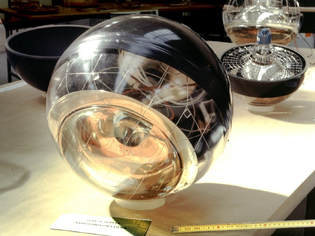Introduction
Following the success of the HAWC observatory in the Northern Hemisphere (Mexico), work has started towards the development of a next-generation observatory in the Southern Hemisphere. Similar to the increase of sensitivity provided by CTA over the current generation of IACTs (H.E.S.S., Veritas and MAGIC), a next generation, large FoV gamma-ray observatory should match the sensitivity and directionality of CTA. The capabilities of such an observatory would be extremely beneficial for monitoring the VHE gamma-ray sky, triggering deep CTA follow-up observations in case of interesting events like AGN flares, binary outbursts, new transients, etc., and thus increasing the science output of both observatories.
Several design options are currently studied and evaluated in parallel, the common goal being to form an international collaboration driving the project. As first crucial step we were outlining the science case of this next-generation instrument in the Southern hemisphere (e.g. Pos(ICRC2017)851) and work towards the selection of an appropriate site most probably in the Andes Mountains. Working towards the design, funding and finally construction of such a next-generation, the "Southern Gamma-ray Survey Observatory (SGSO)" alliance was founded end of 2017. I led the "alliance" until it converged into the SWGO collaboration that was established in 2019. Details can be found on the website of SWGO.
I was also leading the AMIGO (Antares Modules in a Gamma-ray Observatory) proposal aiming at recovering the optical modules of the ANTARES deep-sea neutrino telescope at the end of its data taking for use in water Cherenkov tanks within the new gamma-ray observatory. The proposal was supported by 45 scientists from 20 institutes and 7 countries but was not followed up by the ANTARES collaboration.
Several design options are currently studied and evaluated in parallel, the common goal being to form an international collaboration driving the project. As first crucial step we were outlining the science case of this next-generation instrument in the Southern hemisphere (e.g. Pos(ICRC2017)851) and work towards the selection of an appropriate site most probably in the Andes Mountains. Working towards the design, funding and finally construction of such a next-generation, the "Southern Gamma-ray Survey Observatory (SGSO)" alliance was founded end of 2017. I led the "alliance" until it converged into the SWGO collaboration that was established in 2019. Details can be found on the website of SWGO.
I was also leading the AMIGO (Antares Modules in a Gamma-ray Observatory) proposal aiming at recovering the optical modules of the ANTARES deep-sea neutrino telescope at the end of its data taking for use in water Cherenkov tanks within the new gamma-ray observatory. The proposal was supported by 45 scientists from 20 institutes and 7 countries but was not followed up by the ANTARES collaboration.
The AMIGO proposal
The optical modules of the ANTARES neutrino telescope
|
The ANTARES telescope Cherenkov light detection is based on 885 optical modules operated in the sea water at a depth greater than 2000 m and a constant temperature of 13.3°C, which have been immersed between 2006 and 2008. After 8 to 10 years of operation, a large fraction of the optical modules is still operational. More details about ANTARES can be found here.
The optical module consists of a pressure resistant glass sphere housing a photomultiplier and its active base providing the high-voltage, slow-control access and the readout of the signal (Anode, 12th and 14th Dyode). The glass sphere has a 17 inch diameter and is qualified up to 700 bar. |
Usage of readout electronics developed for CTA
The readout and trigger electronics of an array of water-Cherenkov detectors have a lot of similarities with electronics being developed for the cameras on Atmospheric Imaging Cherenkov Telescopes. With the Cherenkov Telescope Array (CTA) currently being under development, high performance and cost efficient readout and trigger electronics are becoming available.
Currently, two options are being studied in parallel:
Currently, two options are being studied in parallel:
- FlashCAM based electronics: The HAWC gamma-ray observatory is currently taking advantage of this development and is utilizing the readout and trigger electronics that is developed for the FlashCAM (a proposed camera solution for a mid-size telescope of CTA) for the high energy extension of the observatory. This high energy extension of the HAWC observatory will consist of 350 relatively small Water-Cherenkov detectors each holding 2500 liters of water. They are arranged in a sparse array with 15 meter spacing surrounding the main array of the observatory (cf. Fig. 5a). Each WCD tank contains an 8-inch PMT, which is readout with the Flash-ADC board developed for FlashCAM. First, preliminary test-bench measurements demonstrated the feasibility to read ANTARES modules with this electronics.
- NectarCAM based electronics: An alternative possibility would be to use a Nectar based electronics, which has also been developed for CTA. The Nectar chip (which interestingly is building on the ARS chip used in ANTARES) has an analogue memory of 1024 cells. The trigger signal is provided by a separate path. Only when a trigger occurs is the signal digitized with a 12bit accuracy and sent to a node (within CTA a camera server) for event building. The analogue to digital conversion is performed by the Nectar chip. The data bandwidth between the tanks and the nodes would thus be drastically reduced in contrast to a FlashCam based readout which would imply that the signals from the PMTs are digitized locally to avoid analogue signal transmission to the nodes through long cables. Since the trigger is performed in the nodes, large amount of data have to be sent there before triggering. The Nectar chip is currently used by the upgraded H.E.S.S. cameras and the NectarCAM camera for CTA.
